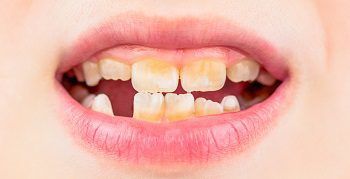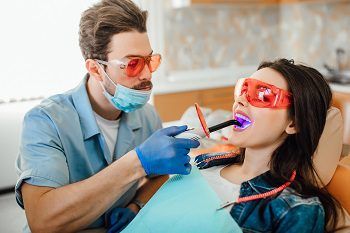Tooth Discoloration: Causes, Prevention, and Treatment.
Have you noticed that your teeth are not as white as they once were, or perhaps even as white as you would like them to be? Tooth discoloration can happen due to a variety of factors. However, many techniques remove stains from teeth and avoid them altogether. Here are some suggestions for maintaining a robust and radiant grin.
Types of Tooth Discoloration
Before purchasing whitening toothpaste or other products, you should be aware of many dental stains. After all, they could not react to whitening procedures similarly, so it's critical to know what you're up against.
- Extrinsic stains are those that are on the surface of tooth enamel. They are simpler to remove because the stain is on the tooth enamel's surface.
- Intrinsic stains: Stains that reach the dentin, the soft layer below the enamel, may need a more aggressive whitening procedure.
- Age-related stains are beneath the enamel and are more difficult to remove since they develop as your teeth and body change with age.
What causes tooth discoloration?
Almost everyone wishes they could have a bright white smile. Your teeth may discolor for a variety of causes. Some things are out of our control, like becoming older or having accidents when we're young, which could affect how our tooth enamel develops. This is why it's crucial to talk to your dentist about your teeth whitening intentions. Your dentist will be able to determine whether your tooth darkening is only lifestyle-related staining, such as from drinking too much coffee, or whether it may be more of a dental health issue.

Even though bleaching is typically done for aesthetic purposes, your dentist can advise you on the best options for your particular stains. The good news is that correcting dental discoloration is frequently possible. That justifies working toward a radiant white smile.
The following are some of the reasons for teeth staining:
- Foods and beverages: starchy foods like pasta or potatoes and coffee, tea, colas, and wines might cause stains.
- Use of tobacco: Using tobacco for smoking or chewing can discolor teeth.
- Poor dental care: Forgetting to clean and floss your teeth can lead to the accumulation of plaque and food stains. Skipping regular cleanings by a dentist can also cause stains to appear.
- Disease: Conditions that inhibit the healthy growth of dentin, the more porous "yellower" core beneath the enamel, and tooth enamel (your teeth's white outer layer), can cause discoloration. Some infections in pregnant women can interfere with your baby's enamel development and stain their teeth. Chemotherapy and radiation to the head and neck are two medical procedures that can stain teeth.
- Medication: It is well-known that some medications can stain developing children's teeth. Tetracycline and doxycycline, medicines, can impact how enamel forms in kids under the age of eight. Teeth can also become stained by mouthwashes and rinses that contain cetylpyridinium chloride and chlorhexidine.
- Dental materials: Some amalgam restorations, mainly silver sulfide, might give your teeth a grayish-black cast.
- Aging: Your teeth's outer coat of enamel wears away with time, revealing the tooth's yellow dentin. The tooth becomes less translucent, making it appear darker. As you age, the dentin in your teeth also increases, reducing the pulp size.
Treatment option to Whiten Teeth
Depending on your stain type, your teeth will become a certain number of shades lighter. There are various treatment choices, and only some are candidates for every whitening technique. Talking with your dentist before using any whitening products is important because the U.S. Food and Drug Administration (FDA) disapproves of them.
At-home Whitening
- Avoid meals and drinks that cause stains.
- I am applying over-the-counter whitening products in tooth-shaped trays or stick-on strips.
- Use the appropriate tooth brushing and flossing practices to clean your teeth daily. (Although you should always practice good dental care, stepping up your game can improve your teeth' appearance if your routine improves.)
Professional Whitening
In-office professional whitening: A dentist will conduct professional whitening, using materials and techniques to hasten the whitening treatment. Your dentist will use a hydrogen peroxide solution. For some items, the bleaching process may need to be sped up with heat and specialized light. Other products available to professionals will have a stronger whitener concentration, occasionally with a desensitizer and some special tray for improved whitener adhesion. When performed by a qualified dentist, the operation is secure.

Dental bonding: In this treatment, your dentist paints a white resin on your tooth and uses a special light to solidify it. The resin is 'bonded' to the tooth by the light to enhance the shape and color of your smile.
Whitening Toothpaste
To target the surface of your teeth, whitening toothpaste uses abrasives and the chemical blue covarine. However, given that the chemical makes your teeth appear whiter, those that include blue covarine might start working after just one brush. It could take some time for whitening toothpaste to begin working.
Whitening Strips
Compared to professional products, whitening strips have a lower hydrogen peroxide content. They are placed on your teeth once or twice daily for the time recommended by the manufacturer. Numerous whitening strip choices come in various bleaching chemical concentrations.
How to prevent tooth discoloration?
- Before going to bed, spend two minutes brushing your teeth and again when you wake up.
- To be safe, choose the proper toothpaste. Your toothpaste should include the American Dental Association (ADA) Seal of Acceptance. It is, therefore, dentist-endorsed.
- Every day, floss between your teeth.
- Avoid foods and beverages like cola, coffee, tea, and red wine that can discolor your teeth.
- Always have a clean, reusable straw to avoid discoloring your front teeth when drinking liquids.
- After consuming acidic or potentially staining beverages like juice, lemonade, coffee, or red wine, sip water and rinse your mouth.
- To avoid cigarette stains, stop smoking.
Conclusion
These days, everyone wants a white, healthy smile. Just be cautious about keeping your smile. Knowing how to whiten your teeth safely will keep you beaming for a long time. Avoid using over-the-counter home whitening kits or DIY teeth whiteners before consulting your dentist.
Contact your Pinole dentist, Dr. Hoss Abar, DDS, MSD, at Abar Orthodontics to know more about tooth discoloration.
Resource:
This media/content or any other on this website does not prescribe, recommend, or prevent any treatment or procedure. Therefore, we highly recommend that you get the advice of a qualified dentist or other medical practitioners regarding your specific dental condition.
More To Explore
About Us
We believe that every patient deserves to feel confident about their smile. Years of experience creating beautiful and flawless smiles.
Opening Hours:
Monday - Thursday: 8:00 AM - 5:00 PM
Friday: 8:00 AM - 12:00 PM
Saturday - Sunday: Closed
Abar Orthodontics, Pinole, CA
1500 Tara Hills Drive., Suite 204
Pinole, CA 94564
Abar Orthodontics, San Leandro, CA
145 East 14th street., #100
San Leandro, CA 94577
© 2025Abar Orthodontics | All rights reserved | Powered by:Vigorant, Inc.
